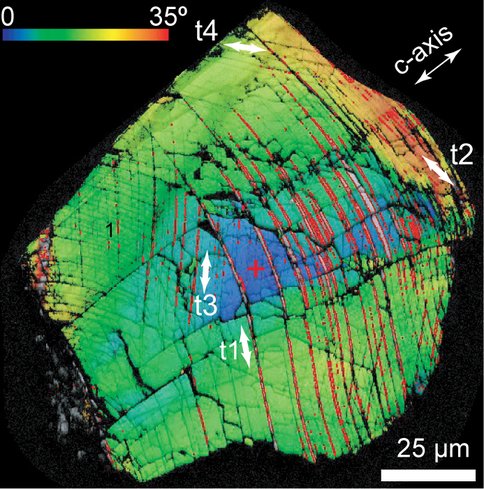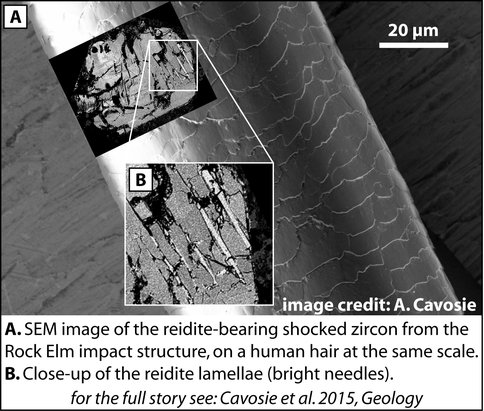2015 Annual Science Report
 University of Wisconsin
Reporting | JAN 2015 – DEC 2015
University of Wisconsin
Reporting | JAN 2015 – DEC 2015
Project 3F: Searching for Ancient Impact Events Through Detrital Shocked Zircons
Project Summary
Understanding how quickly planetary surface environments evolve on newly accreted worlds is critical for predicting when habitable conditions are established. The meteorite impact history of the inner solar system strongly indicates that the Earth was subject to a global impact bombardment during the first few hundred million years after accretion. The scope, timing, and consequences of this profound process are hotly debated. This project investigated populations of detrital zircons in Archean sedimentary rocks to search for tell-tale signs of impact processes in the form of shock-induced microstructures that are diagnostic of impact. Such features have been shown to survive in detrital shocked zircons eroded from known impact structures on Earth, including the Vredefort, Sudbury, and Santa Fe craters. We have investigated populations of 1,000 zircons per sample using backscattered electron imaging of grain exteriors with a scanning electron microscope. Thus far we have surveyed zircons separated from rocks collected from the Yilgarn craton (Australia), North China craton (China), Wyoming craton (USA), the Superior craton (Canada). While intriguing microstructures have been observed, thus far no confirmed shock microstructures have been encountered in our Archean sample suites. Our inability the identify shocked grains in populations of 1,000 zircons (per sample) does not necessarily mean shocked grains are absent; our results provide constraints that if they are present, they are in abundances of <0.1% in the detrital population of the rocks investigated. We are currently in the process of more in-depth surveying (e.g., >1000 grains/sample) to test for very low frequency occurrency events. Our detailed search continues…
Project Progress
Understanding how quickly planetary surface environments evolve on newly accreted worlds is critical for predicting when habitable conditions are established (Cavosie, 2014). The meteorite impact history of the inner solar system strongly indicates that the Earth was subject to a global impact bombardment during the first few hundred million years after accretion. The scope, timing, and consequences of this profound event are hotly debated. In 2015 this project focused on the continued search for detrital shocked zircons in the Precambrian rock record; applications of detrital shocked zircons for dating the lunar impact history; a search for shocked zircons at a deformed impact crater; and concluded with a serendipitous discovery of a new locality for the rare high pressure ZrSiO4 polymorph reidite.
Searching the Precambrian detrital zircon record- An example from the Superior Craton, Canada
In 2015, we investigated a suite of 1,000 detrital zircons from the Chelmsford Formation, a Precambrian turbidite deposited at ~1.75 Ga into the Sudbury impact basin in Ontario Canada. The rationale for investigating these zircons for the presence of shock microstructures is that the turbidite is a proximal deposit inside an impact basin, and thus has a high likelihood of containing shocked minerals from the local bedrock. Identification of detrital shocked zircon in this deposit would demonstrate the preservation of detrital shocked zircons in rocks that were deposited and lithified nearly 2 billion years ago. Instead, our survey of 1,000 grains by SEM did not yield any grains with shock microstructures. One interpretation is that the contribution from local rocks was limited to the Sudbury igneous complex, which does not contain shocked zircons. Another possibility is that the zircons are not locally derived.
A critical test for chronology of impacts on the Moon from detrital shocked zircons
One important and largely unconstrained aspect of the impact history of the Earth is the timing and flux of early impacts. As there are no intact Hadean-age impact craters on Earth, the impact history of the Moon is often used as a proxy for when Earth experienced large impacts. Many studies have interpreted U-Pb ages of lunar zircons as recording ages of impacts on the Moon. This assumes that U-Pb ages of lunar zircons were shock-reset and record the impact age. Our group has studied the U-Pb ages of shock-twinned detrital zircons eroded from the Vredefort Dome impact in South Africa (Fig. 1), and found that the vast majority of grains (>99%) do not record the known age of impact (2.02 Ga), and instead record bedrock crystallization age. Bedrock ages were found in 100% of detrital shocked zircons that contained various types of planar microstructures (Cavosie et al., 2015a). An impact age was only found in one grain, which preserved a microstructure of neoblastic zircon, formed as a consequence of recrystallization due to the high temperatures of impact. The results of this study demonstrate that ages of lunar zircons with planar microstructures are equivocal, and can not be assumed to record impact events in the absence of other microstructure evidence. These findings highlight the limitations of zircon for recreating the lunar impact history.
A search for shocked zircon at a deformed impact structure
One reality when searching the Precambrian or Archean record for evidence of ancient impact events is that little crust from this time remains intact. To date, there are no examples impact structure in rocks that have experienced tectonic deformation and/or metamorphism, as might be encountered in the Precambrian. To develop methods designed for this type of exploration, we conducted a search for shocked zircons at a tectonically deformed impact structure where they had not previously been reported, and chose the Santa Fe impact structure in New Mexico (USA). The Santa Fe structure is ideal, as it is a confirmed impact structure based on the presence of shocked quartz and shatter cones (Fackelman et al., 2008), but it is has been tectonically dismembered, and effectively only exists as one ~2 × 6 km fault block in near Santa Fe. There is no circular structure, no central uplift, no crater rim, no geophysical anomalies, or any other distinguishing feature beyond shocked quartz and shatter cones along a ~2 km roadcut in the area. Both the size (6-13 km) and age (1200-400 Ma) are poorly constrained.
In 2015, a graduate student in charge of this project, Pedro Montalvo, surveyed >6,000 detrital zircons from sediment samples collected from this mountainous area, and confirmed the presence of shocked zircons in this population. The implication of these results for studies of Precambrian rocks is that detrital shocked zircons can provide a record of impact craters that have not only eroded, but also ones that have been tectonically dismembered and may thus not be recognizable at the outcrop scale.
Discovery of the ultra-rare high pressure ZrSiO4 polymorph reidite at Rock Elm.
The search for detrital shocked minerals in the Precambrian sedimentary record necessarily involves detailed investigation of siliciclastic rocks, generally sandstone, and the detrital zircons they contain. A field site in western Wisconsin, the Rock Elm impact crater, is a ~6 km diameter Ordovician age impact into the Cambrian Mt. Simon sandstone (French et al., 2004), and thus offers an opportunity to study shock metamorphism of sandstone at a deeply eroded impact structure, as might have once existed and perhaps been preserved in the Precambrian rock record.
During a field trip with NAI summer intern students at the Rock Elm impact structure in 2013, a sample of a complex polymictic impact breccia was collected to investigate if it contained shocked quartz. A petrographic study reporting shock-deformed quartz was presented at the LPSC in 2014 (Arana and Cavosie, 2014). Further investigation of the breccia sample revealed the presence of numerous, <50 µm-sized detrital zircons. A survey of ~100 zircons in the thin section revealed that one was intergrown with sub-um lamellae of a high atomic number phase (Fig. 2).
EBSD mapping of this phase confirmed that it is reidite, the rare high pressure polymorph that forms at pressures >30 GPa.
Publications
-
Cavosie, A. J., Erickson, T. M., & Timms, N. E. (2015). Nanoscale records of ancient shock deformation: Reidite (ZrSiO4) in sandstone at the Ordovician Rock Elm impact crater. Geology, 43(4), 315–318. doi:10.1130/g36489.1
-
Cavosie, A. J., Erickson, T. M., Timms, N. E., Reddy, S. M., Talavera, C., Montalvo, S. D., … Moser, D. (2015). A terrestrial perspective on using ex situ shocked zircons to date lunar impacts. Geology, 43(11), 999–1002. doi:10.1130/g37059.1
-
Valley, J. W., Reinhard, D. A., Cavosie, A. J., Ushikubo, T., Lawrence, D. F., Larson, D. J., … Strickland, A. (2015). Nano- and micro-geochronology in Hadean and Archean zircons by atom-probe tomography and SIMS: New tools for old minerals. American Mineralogist, 100(7), 1355–1377. doi:10.2138/am-2015-5134
-
PROJECT INVESTIGATORS:
-
RELATED OBJECTIVES:
Objective 1.1
Formation and evolution of habitable planets.
Objective 4.1
Earth's early biosphere.
Objective 4.3
Effects of extraterrestrial events upon the biosphere


